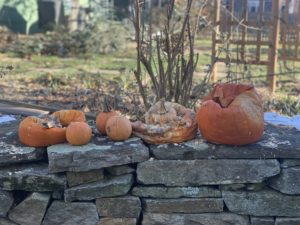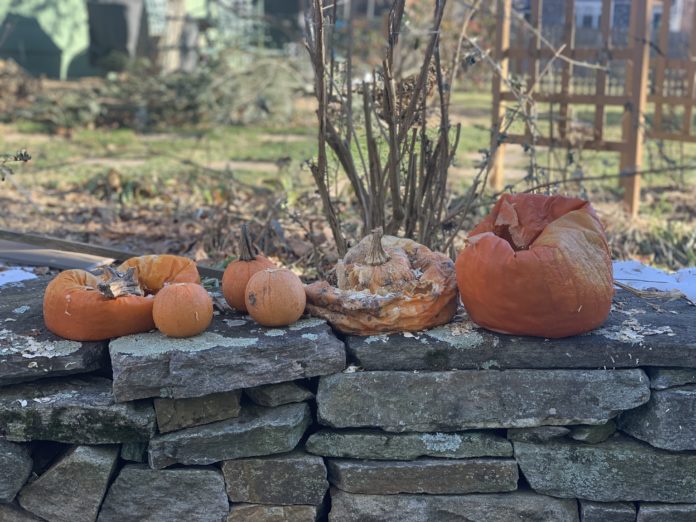Ginger and I are not good at throwing away pumpkins.
We buy them every October and then just never seem to discard them as the winter wanders in. We aren’t carvers. The pumpkins sit whole doing nothing but being big and round and orange until the forces of nature that surround them take their toll.
It started when we lived in Charlestown, Massachusetts, the neighborhood of Boston that houses the USS Constitution and Bunker Hill. We bought a pumpkin for Halloween and then forgot to move it from in front of our 1840 row house. As the gourd caved in and sort of melted, the neighbors’ kid would ask, “Mom, are they ever going to move that thing?”
And so we didn’t, just for fun.
When spring came, I shoveled up the few dried seeds and skin that was left and we waited for October to return.
This year, the largest pumpkin in the row has never moved. It was born there. A volunteer vine that must have grown from the compost sprouted in our flower bed and we let it grow. That pumpkin has been in the same place since it was big enough to notice, some time in the summer.
the summer.
The stone wall that supports it is a chipmunk hostel, much to the chagrin of the Schnauzers. In early December the chipmunks started chewing into the side of the pumpkin, and then burrowing in where they could feast on all the gourdy goodness inside. As they died, the pumpkins fed the neighborhood.
Around Thanksgiving I learned that most of the cans of “100% pumpkin” that we use for our holiday pies are not filled with the stuff of stone wall sitters and jack-o-lanterns. Legally, pumpkin can refer to a number of squashes, most of which taste better than the ones the chipmunks enjoyed, and they are easier to peel and cook than the big boys as well. My go-to pumpkin pie recipe comes with instructions to use a good bit of sweet potato to make the pumpkin taste more pronounced.
Our back patio has let us watch the life cycle of a pumpkin from seed to squash to food to compost and back to seed–all stages of life, all stages of cooperation and relationship. Since I took the picture, the wilting gourds have been buried by snow three times and they have disintegrated a bit more.
One of the things I have learned from the folks I work with in our communal garden is not to clean up that much. It seems Ginger and I were on to something without knowing what we were doing. One friend told me not to cut the butterfly bush back before winter because the dead branches have nutrients to share and will make a stronger plant when it resurrects in the spring. Tom, my garden maven, leaves most everything in the ground from dead tomato plants to the weeds to help hold the soil through the fall and winter. Just because the plants are dead doesn’t mean they are useless.
The plants we harvest for food notwithstanding, the extravagance of life that lives and grows and dies around us reminds us over and over that being useful is not the only reason to be alive. The extraordinary inefficient extravagance of most of what sprouts and blooms and changes color is not doing much of anything other than sprouting and blooming and showing off. Our pumpkin took its place on the wall because that is where it grew. It spent its whole life not doing a damn thing other than being a pumpkin. The chipmunks made use of it, but that was never the point.
One of these days–after things have thawed and the pumpkins are no longer frozen to the stone wall–it will come time to move what’s left of the gourds. But I won’t throw them away. I won’t even move them far, actually. I’ll probably lust scrape them off the wall into the flower bed behind it and see what happens. By then, it won’t be too many weeks until we are raking the leaf mulch off the beds in the communal garden and talking about what to plant, even as we wait to see what comes up on its own.
Something always volunteers.
The root of the word volunteer means “of one’s free will”–a meaning truer to the pumpkin than our sense of waiting for someone to raise their hand and offer to be of use. Jesus knew nothing of pumpkins when he talked about being like the lilies that didn’t work at all but volunteered to light up the hillside with their beauty. They did do anything; they just were–and that was enough.
Every season offers room for volunteers flaunting their free will and the hopeful abandon of useless beauty even as all of it carries the the slight scent of compost and the reminder that none of us lasts that long. But while we’re here, we can always volunteer.
Peace,
Milton

Thank you for your unabashed hospitality!!
Thank you, Milton.
Your reflection brings to mind these lines I love of Gunilla Norris:
“The soul leaps and burns for its own joy. Our work is not to be efficient or functional, but to be alive and immersed in the unfolding beauty of all that is.”